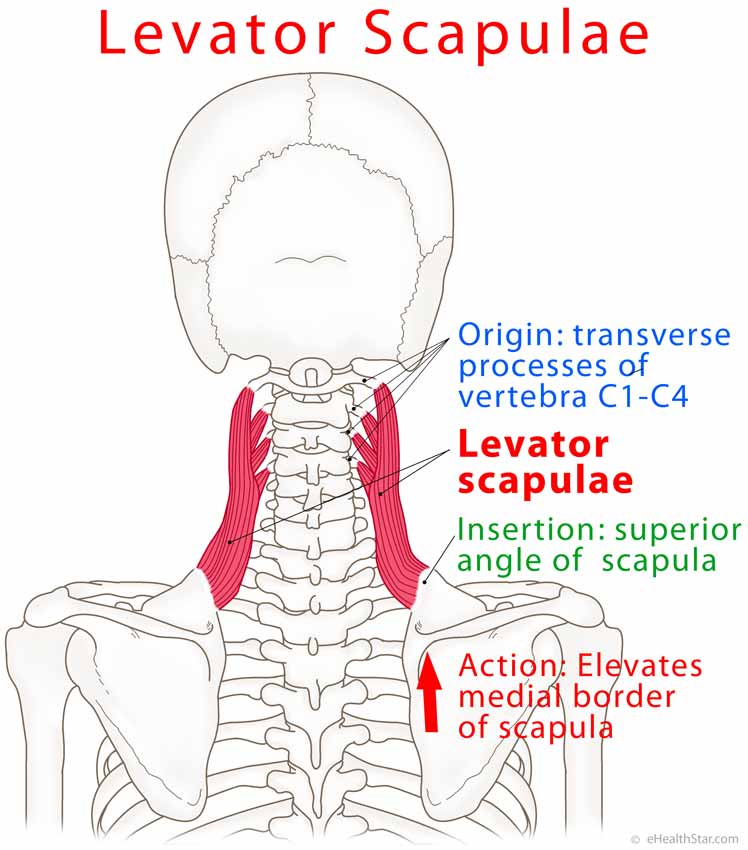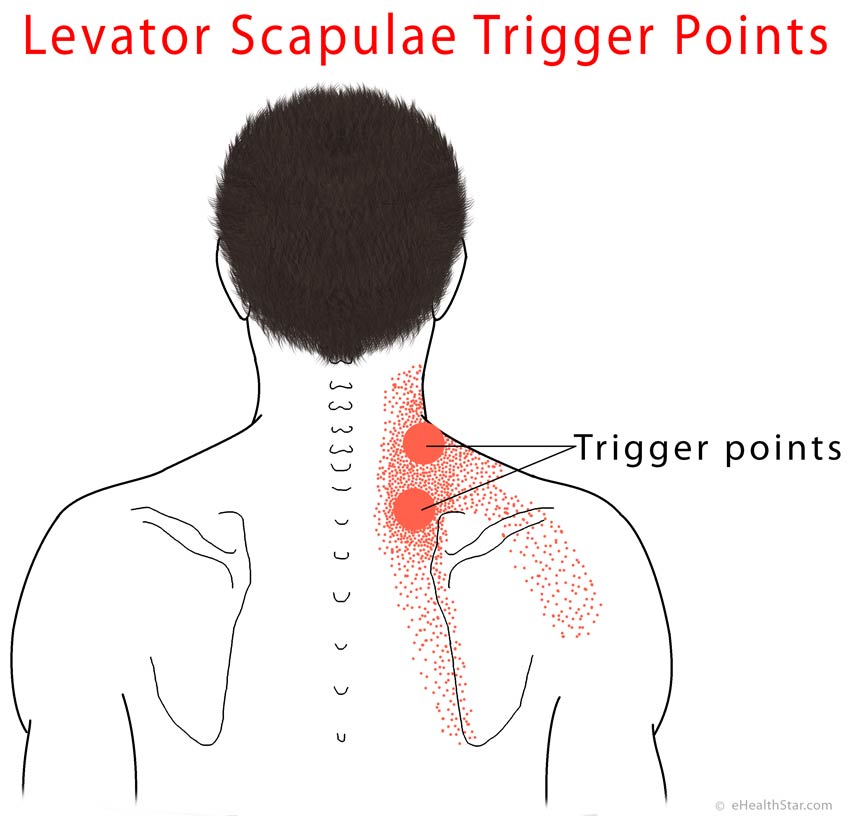Levator Scapulae Location
Levator scapulae is located on each side of the neck; it extends from the shoulder blade (scapula) to the cervical spine.
Origin
Levator scapulae originates from the transverse processes of the first 4 cervical vertebrae (C1-C4) [1].
Insertion
Levator scapulae inserts to the upper part of the medial border of scapula [1].
Function (Action)
- Elevates the medial border of scapula (and thus assist in shrugging) and downwardly rotates its lateral angle (and thus lowers the shoulder joint)
- Pulls scapula upwards and medially (with the help of the trapezius and rhomboid muscles)
- Bends the neck to the either side (laterally, ear to shoulder)
- Fixes the neck when the head is bent forward
- Assists in extending the neck
- Reference: [1,3]
Innervation
- Dorsal scapular nerve (C5)
- Ventral primary rami of the spinal nerves C3 and C4
- Reference: [1]
Blood Supply
Levator scapulae receives the blood via the dorsal scapular artery [2].
.
Picture 1. Levator scapulae anatomy: origin, insertion, action
Related anatomy:
Myofascial Pain and Trigger Points in Levator Scapulae
Myofascial pain is chronic pain that arises from the muscle sheath called fascia.
Symptoms
Symptoms and signs associated with pain in the levator scapulae muscle [3]:
- Difficulty rotating the head toward the affected side
- Difficulty abducting the arm (extending it sideways and above the shoulder level)
- Subjective feeling of shortness of breath due to pain in the neck during inhalation
- Trigger points at the angle of the neck on either side (about 1/2 inch and 1 and 1/2 inch above the medial angle of the scapula (Picture 2). Applying pressure on the trigger points causes pain that radiates to the nearby areas.
Picture 2. Levator scapulae trigger points location and pain distribution
Causes
Myofascial pain in the levator scapulae muscle can be caused by [3]:
- Prolonged reading or writing with the neck bent forward or computer work with the keyboard positioned too high
- Holding the phone between the ear and shoulder
- Sleeping on the stomach with the head on a thick pillow
- Repetitive overhead arm movements, such as during swimming
- Carrying a heavy bag with a strap over the shoulder
- Driving while holding the steering wheel at “10 and 2” position
- Emotional stress, pneumonia or other cause of hyperventilation
- Limping on one leg or using an improperly fitting walking cane or crutches
Differential Diagnosis
Apart from the levator scapulae, the pain in the angle of the neck can originate from:
- Stiff neck from bad posture
- Wry neck (torticollis) [4]
- Strain of the sternocleidomastoid, trapezius or scalene muscles
- Whiplash injury
- Herniated disc in the neck
- Herpes zoster (shingles)
- Fibromyalgia
- Snapping and SICK scapula syndrome and other causes of shoulder blade pain
Treatment
The following may relieve the pain in the elevator scapulae:
- Massaging the area behind the angle of the neck with fingers or cane massager
- Massaging with a tennis ball or lacrosse ball against a wall
- Myofascial pain release performed by a physiotherapist
The effectiveness of acupuncture, dry needling and steroid injections in relieving pain in levator scapulae is not known. Analgesics and muscle relaxants probably do not work well.
Levator Scapulae Stretch
Regular stretching of the levator scapula can help prevent trigger points in the muscle, especially when started early after the pain onset. Spraying the sore muscle with vapocoolant spray reduces pain during stretching.
An example of a stretching exercise for levator scapulae:
Sit down with your back straight, turn the head to the right, place the right hand to the top of the head and bend the head down, so you will look toward your right hip. Do not push the head with the hand. Hold for several seconds and repeat 2 or 3 times on each side.
Video 1. Levator scapulae anatomy, function and causes of pain
Key Points
- To prevent levator scapulae muscle pain, avoid holding your arms high during computer work and driving.
- Use a thin pillow in bed.
- Face with your work duties and avoid unnecessary stress.
- When already in pain, try stretching exercises and massage rather than acupuncture, analgesics or injections.
- References
- Levator scapulae muscle GetBodySmart
- Levator scapulae University of Washington, Department of Radiology
- Levator Scapulae Muscle: Location, Actions, and Trigger Points Ground Up Strength
- Torticollis (Wry neck) NCEMI



